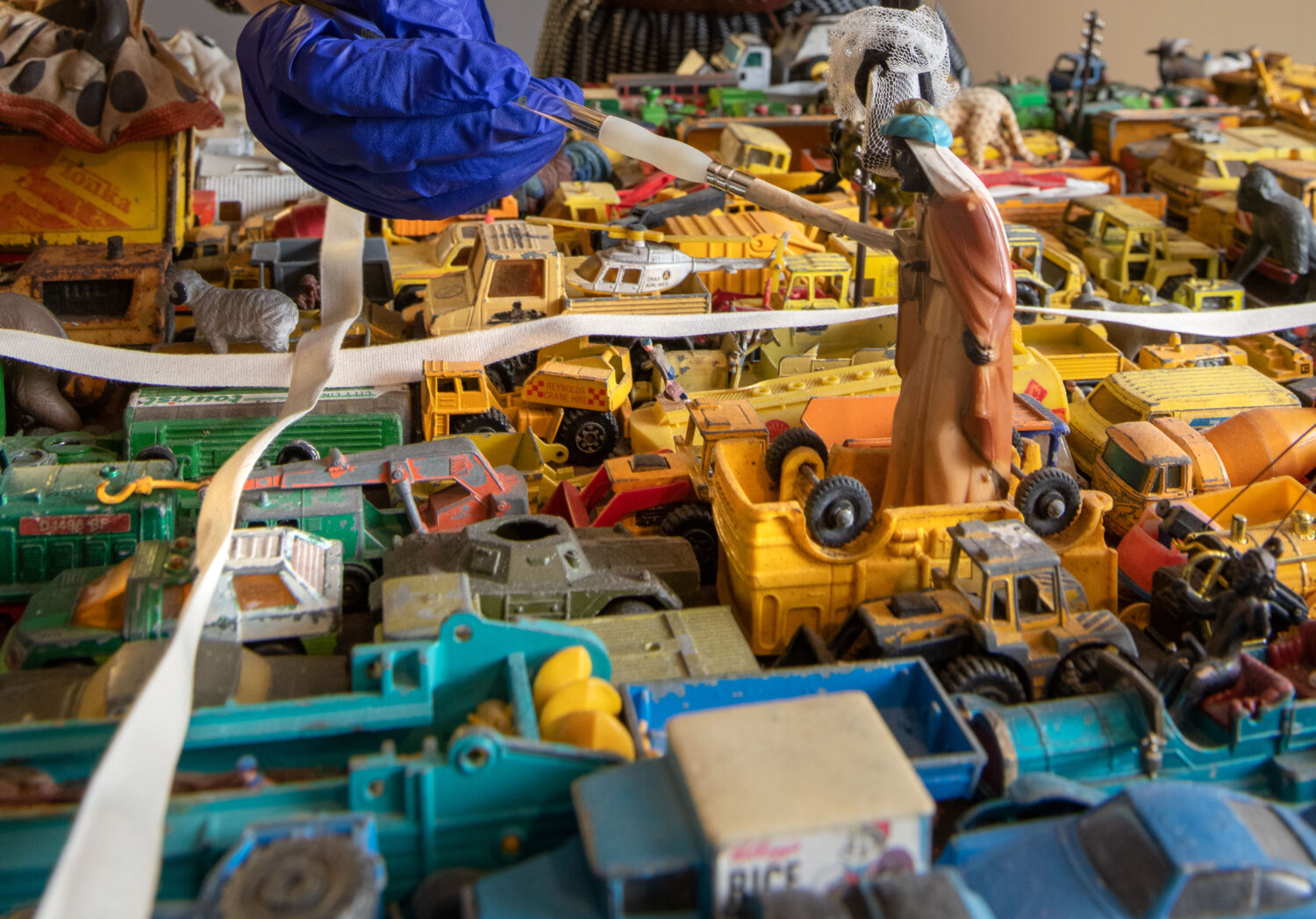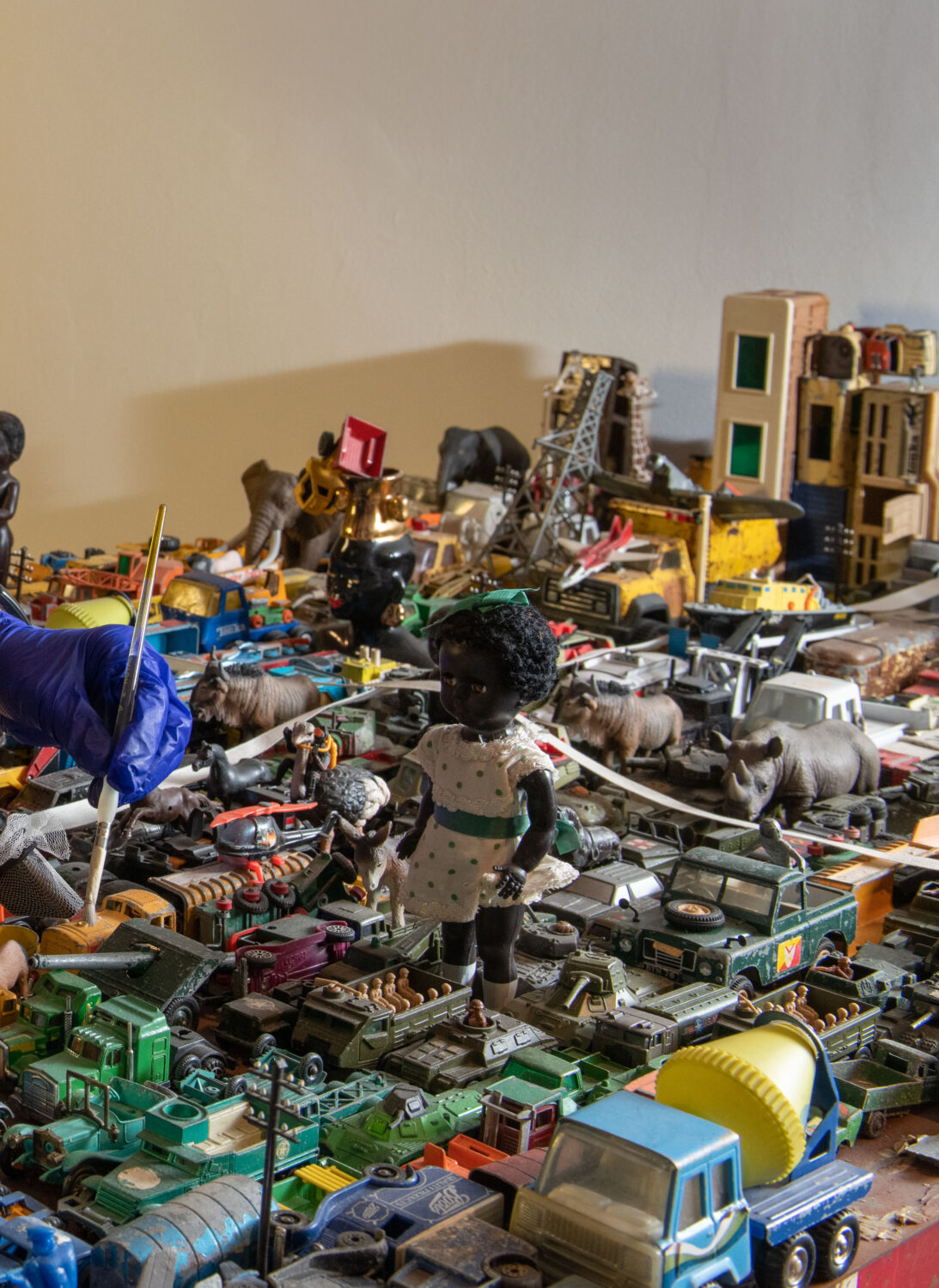A First Look Inside The Reflections Room, London Docklands’ New Contemporary Art Space
By Zak Ové and Jean-François ManicomThis week, London Museum Docklands will unveil The Reflections Room, a new permanent space dedicated to contemporary art, with exhibitions probing the topics and historical narratives represented throughout the museum’s collections—such as immigration, colonialism, slavery, and Black British identity. The new space will be inaugurated on 29 November with the presentation of Exodus, a layered and symbolically fraught work by British-Trinidadian artist Zak Ové.
Working across sculpture, film, and photography, Ové—who has previously shown at LACMA, Somerset House, and Yorkshire Sculpture Park, among other institutions—fuses African and Caribbean traditions with modern materials to explore ideas around mythology and diaspora, often proposing speculative futures through his work. On the occasion of the new presentation, Ové and London Museum Docklands Senior Curator Jean-François Manicom discuss The Reflections Room, Exodus, and more, in a conversation for Something Curated.

Jean-François Manicom: London Museum of Docklands houses a lot of material coming from the time when the UK was a vast empire. We have evidence of the movement of goods, merchandise and assets from around the world. But you can’t move objects without moving people.
You can’t trade with Africa, India, or China without expecting people to follow. This is something we are very aware of at the museum. Here in Docklands, we’re not only speaking about the slave trade but every form of trade and exchange. This is why we see contemporary art as an essential medium to help people feel and understand what is often hard to those who inherit its legacy. Artists, brilliant artists, help us embody the pain and trauma of these complex histories. This is why we decided to open The Reflections Room, a contemporary space in the museum, launching this month.
We chose Zak Ové for several reasons: he is a remarkable artist, and his background allows him a unique perspective—both British and Caribbean. This blend, which I share, creates a feeling of being in-between, a sense of unbalance between two worlds. Starting with Zak and his powerful piece Exodus was exactly what we needed to inaugurate this space. This isn’t just another exhibition of Zak Ové’s work; it’s the beginning of a journey for a museum that traditionally wouldn’t have a dedicated contemporary art room.
Zak Ové: I’m very excited to be working with you Jean-François on this project as the inaugural artist, and I think Exodus is an excellent choice of work. To fortify what you were talking about, my journey as an artist is very much about the analysis of this duality that I share with you, being both from Europe and the Caribbean, and a way for me to really examine what that heritage is, the importance of being mixed in this way, and, historically, what that has brought to cities like London.
I was looking at post slavery, the importance and influence of migration and immigration to the UK, and how it’s changed Britain entirely. And I think this is a really interesting starting point. I made Exodus specifically to deal with an issue that was happening in Nigeria and the UK, where children were being sacrificed for being witches through extremities of the Christian church. This immediately is a follow on to the heavy arm of colonialism that indoctrinated Africa and Black people in the UK. I wanted to make a piece of work from children’s toys that examined the nostalgia and tried to convey the emotional trauma of what it was like to be in that situation and the necessity to leave.
Migration happens for all kinds of reasons, often to procure a success, to follow through on an adventure, but more often than not, it’s also about how we leave a situation that doesn’t work for us, to try and enter a new world where we might be given new standards of equality that lead to the fruition of families and children for the future. Exodus is very much about that, that situation, about what it is to be an African child forced to leave your country of origin, forced to enter a new culture, a new world with a new perspective, and hopefully to be given a new chance.

I’m fascinated by the history of what Jean-François looks after at the London Museum Docklands. The history is very important to people of African origin. It really examines up close what the history of slavery is, how colonialism shifted the money from slavery to build the city of London, and how invisibly African people really helped to build, if you like, the horizon of the Great Western world in its modernity. My specialty as an artist is an examination of that invisibility of who we are and who we were hand in hand, for young people to see what our contribution has been, from our ancestry to our parents generation and through to the current day. Works like this have to examine the past, but also act as a tool of emancipation for children.
What I hope Jean-François, in a collaboration like this, is to unearth questions about our history, our commonality, our Britishness, and what it is to be British, and really to examine how that has shifted and how it has to shift even more to really open up a bigger, wider sense of equality for all.
JFM: In The Reflections Room, visitors will approach Exodus directly, with a video conversation between Zak and me on one side, and on the other side, a series of large maps. These maps illustrate the history of exodus from the Middle Ages, showing how people have moved throughout history to save their lives or those of their families. Migration is rarely a choice; it is often a necessity.
ZO: It’s interesting what you’re saying, because there’s one thing to die, but “exodus” also refers to the safeguard of a community against genocide, and the genocide isn’t just the killing of the individuals, it’s the killing of the community and its history. It’s taking away from an entire people and an acknowledgement of them and their existence. And I think when you start to look at Exodus in those terms, you understand that this isn’t just the fear of the loss of one’s individual life. It’s the fear that your entire history, structure, ethos, ideas are removed, literally, and with this, as you have rightfully explained, this is something that hasn’t disappeared in modernity. It got worse.
So again, how do we address this to young people to understand that these atrocities must never happen? How do we speak about situations like this? To the children who are refugees coming out of these circumstances so that they might feel more safeguarded and protected in their new life here in Britain—this is the key. And I think this exhibition and the room that Jean-François has started to set up here in the museum is about the acknowledgement of these stories, how they intertwine, and how, if you like, refugees coming from these situations will become part of the Great British story in the future. I hope that the children that see these exhibitions will contribute to what Britain will become and the changing colours that we will see next that take us from where we’re at to where we should be.
Exodus will be at London Museum Docklands from 29 November 2024 to May 2025.
Feature image: Exodus by Zak Ové. Installation at London Museum Docklands. © London Museum